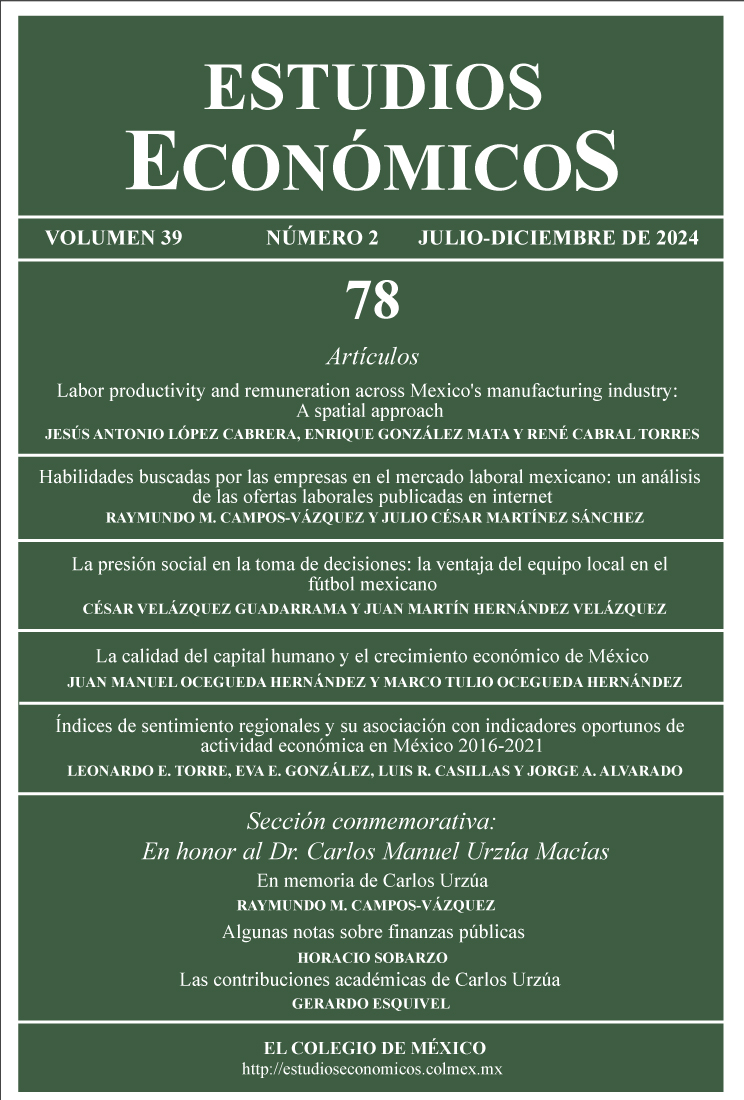
Publicado 2024-07-31
Palabras clave
- crecimiento económico,
- capital humano,
- calidad de la educación,
- análisis por entidades federativas,
- datos de panel
Cómo citar
Resumen
Se analiza la relación entre capital humano y crecimiento económico en México utilizando datos de panel por estados. Se miden los efectos de la escolaridad por nivel educativo y se controla por diferencias en la calidad del capital humano con dos variables alternativas: el puntaje en matemáticas de los exámenes PISA y el valor agregado atribuible al capital humano dentro de la masa salarial total. Se concluye que las discrepancias en la calidad del capital humano y los avances diferenciados en la cobertura de educación superior entre estados determinaron que el esfuerzo educativo de las últimas dos décadas tuviera efectos regionales dispares sobre el crecimiento económico.
Descargas
Citas
- Aghion, P. y P. Howitt. 1992. A model of growth through creative destruction, Econometrica, 60(2): 323-351. DOI: https://doi.org/10.2307/2951599
- Aghion, P. y P. Howitt. 2009. The Economics of Growth, Cambridge, The MIT Press.
- Becker, G.S. 1962. Investment in human capital: A theoretical analysis, Journal of Political Economy, 70(5): 9-49. DOI: https://doi.org/10.1086/258724
- Becker, G.S. 1964. Human Capital. A Theoretical and Empirical Analysis with Special Reference to Education, Nueva York, Columbia University Press.
- Benhabib, J. y M. Spiegel. 1994. The role of human capital in economic development. Evidence from aggregate cross-country data, Journal of Monetary Economics, 34(2): 143-173. DOI: https://doi.org/10.1016/0304-3932(94)90047-7
- Benhabib, J. y M. Spiegel. 2005. Human capital and technology diffusion, en P. Aghion y S.N. Durlauf (eds.), Handbook of Economic Growth, Amsterdam, Elsevier. DOI: https://doi.org/10.1016/S1574-0684(05)01013-0
- Benos, N. y S. Zotou. 2014. Education and economic growth: A meta-regression analysis, World Development, 64: 669-689. DOI: https://doi.org/10.1016/j.worlddev.2014.06.034
- Brock, G. y V. Germán-Soto. 2013. Regional industrial growth in Mexico: Do human capital and infrastructure matter?, Journal of Policy Modeling, 35(2): 228-242. DOI: https://doi.org/10.1016/j.jpolmod.2012.10.003
- CONASAMI. 2020. Los salarios mínimos profesionales y generales por áreas geográficas, https://www.gob.mx/conasami/.
- de la Fuente, A. 2020. Capital humano y crecimiento: teoría, datos y evidencia empírica, Papeles de Economía Española, 164: 60-75.
- Garza-Rodriguez, J., N. Almeida-Velasco, S. Gonzalez-Morales y A. P. Leal-Ornelas. 2020. The impact of human capital on economic growth: The case of Mexico, Journal of Knowledge Economy, 11: 660-675. DOI: https://doi.org/10.1007/s13132-018-0564-7
- Gálvez-Soriano, O. 2020. Could education increase the economic growth of Mexico?, Análisis Económico, 35(89): 37-64. DOI: https://doi.org/10.24275/uam/azc/dcsh/ae/2020v35n89/Galvez
- Germán-Soto, V., R.E. Rodríguez-Pérez y C.N. Escamilla-Jiménez. 2013. Acumulación y desigualdad del capital humano entre los estados mexicanos durante 1960- 2008, Paradigma Económico, 5(2): 5-31.
- German-Soto, V., R.E. Rodríguez-Pérez, y A.G. Gallegos-Morales. 2020. Exposición a la globalización y convergencia regional en México, Estudios Económicos, 70(35): 267-295. DOI: https://doi.org/10.24201/ee.v35i2.404
- Grossman, G.M. y E. Helpman. 1994. Endogenous innovation in the theory of growth, Journal of Economic Perspectives, 8(1): 23-44. DOI: https://doi.org/10.1257/jep.8.1.23
- Hanushek, E.A. y D.D. Kimko. 2000. Schooling, labor force quality, and the growth of nations, American Economic Review, 90 (5): 1184-1208. DOI: https://doi.org/10.1257/aer.90.5.1184
- Hanushek, E.A. y L. Woessmann. 2008. The role of cognitive skills in economic development, Journal of Economic Literature, 46 (3): 607-668. DOI: https://doi.org/10.1257/jel.46.3.607
- Hanushek, E.A. y L. Woessmann. 2010. Education and economic growth, en P. Peterson, E. Baker y B. McGaw (eds.), International Encyclopedia of Education, Vol. 2, 245-252, Elsevier. DOI: https://doi.org/10.1016/B978-0-08-044894-7.01227-6
- Hanushek, E.A. y L. Woessmann. 2015. The Knowledge Capital of Nations: Education and the Economics of Growth, The MIT Press. DOI: https://doi.org/10.7551/mitpress/9780262029179.001.0001
- Heller-Sahlgren, G. y H. Jordahl. 2023. Test scores and economic growth: Update and extension, Applied Economics Letters, 31(11): 1024-1027. DOI: https://doi.org/10.1080/13504851.2023.2168604
- INEE. 2020. Bases de datos sobre las evaluaciones PISA, https://historico.mejoredu.gob.mx/evaluaciones/pisa/.
- INEGI. 2021. Banco de información económica, https://www.inegi.org.mx/app/indicadores/bie.html.
- INEGI. 2022. Encuesta nacional de ocupación y empleo, https://www.inegi.org.mx/programas/enoe/15ymas/.
- INEGI. 2023. Datos, https://www.inegi.org.mx/datos/#Programas.
- Lucas, R. 1988. On the mechanics of economic development, Journal of Monetary Economics, 22 (1): 3-42. DOI: https://doi.org/10.1016/0304-3932(88)90168-7
- Mankiw, G., D. Romer y D. Weil. 1992. A contribution to the empirics of economic growth, Quarterly Journal of Economics, 107(5): 407-437. DOI: https://doi.org/10.2307/2118477
- McMahon, W. 1999. Education and Development. Measuring the Social Benefits, Nueva York, Oxford University Press.
- Mincer, J. 1974. Schooling, Experience and Earnings, Nueva York, National Bureau of Economic Research.
- Montero Granados, R. 2011. Efectos fijos o aleatorios: test de especificación, Documento de Trabajo, Economía Aplicada, Universidad de Granada.
- Mulligan, C. y X. Sala-i-Martin. 1997. A labor income-based measure of human capital, Japan and the World Economy, 9(2): 159-191. DOI: https://doi.org/10.1016/S0922-1425(96)00236-8
- Mulligan, C. y X. Sala-i-Martin. 2000. Measuring aggregate human capital, Journal of Economic Growth, 5: 215-252. DOI: https://doi.org/10.1023/A:1009893417085
- Nelson, R. y E. Phelps. 1966. Investment in humans, technological diffusion, and economic growth, American Economic Review, 56(1): 69-75.
- Ocegueda-Hernández, J.M. 2015. Divergencias de tasas de crecimiento entre las economías estatales de México, 1993-2010, Región y Sociedad, 27(64): 139-182. DOI: https://doi.org/10.22198/rys.2015.64.a313
- Ocegueda-Hernández, J.M., R. Varela-Llamas, R.A. Castillo-Ponce. 2014. Diferencias de crecimiento entre los estados de la frontera norte de México. Una explicación, Economía, Teoría y Práctica, 41: 9-44.
- Phelps, E. 1995. Comments on Gregory Mankiw’s paper: “The growth of nations”, Brookings Papers on Economic Activity, 1: 311-313. DOI: https://doi.org/10.2307/2534576
- Pritchett, L. 2001. Where has all the education gone?, World Bank Economic Review, 15 (3): 367-391. DOI: https://doi.org/10.1093/wber/15.3.367
- Romer, P. 1990. Endogenous technological change, Journal of Political Economy, 99 (5): 71-102. DOI: https://doi.org/10.1086/261725
- Ros, J. 2013. Rethinking Economic Development, Growth and Institutions, Nueva York, Oxford University Press.
- Schultz, T.W. 1961. Investment in human capital, The American Economic Review, 51(1): 1-17.
- SEP. 2023. Reporte de indicadores educativos, https://www.planeacion.sep.gob.mx/estadisticaeducativas.aspx.
- Valero, A. 2021. Education and economic growth, Discussion Paper No. 1764, Centre for Economic Performance. DOI: https://doi.org/10.4324/9780429202520-20
- Valero-Gil, J.N. y M. Valero. 2021. Human capital and state income differences in Mexico, Applied Economics, 54(13): 1544-1561. DOI: https://doi.org/10.1080/00036846.2021.1980197
- Walke, A., T. Fullerton, M. Barraza, y L. Domínguez. 2015. An empirical analysis of education, infrastructure, and regional growth in Mexico, Journal of Economics and Development Studies, 3(4): 1-12. DOI: https://doi.org/10.15640/jeds.v3n4a1
